Once upon a time, there was a poor old woman named Hungni, and she had a son named Sachuli who was a little bit silly. She had to ask people for food every day to live.
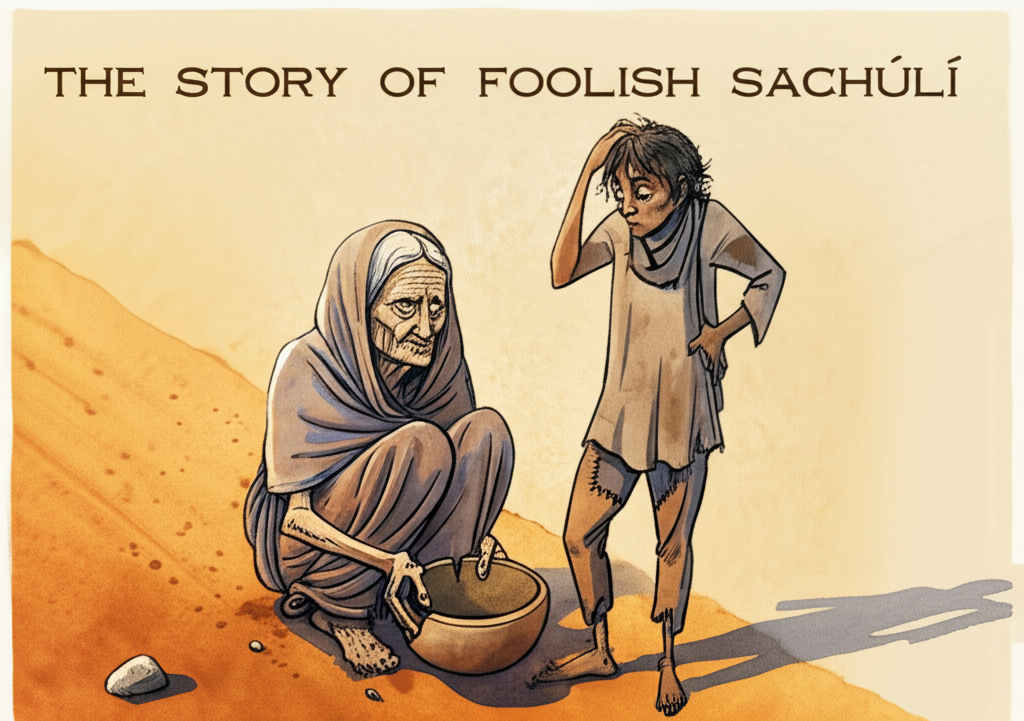
One day, when Sachuli was bigger, he asked his mom, “What makes people laugh?” His mom said, “If you throw a little rock at them, they might laugh!” So one day, Sachuli went to a well. Three women came to get water. Sachuli thought, “I’m going to make one of them laugh!”
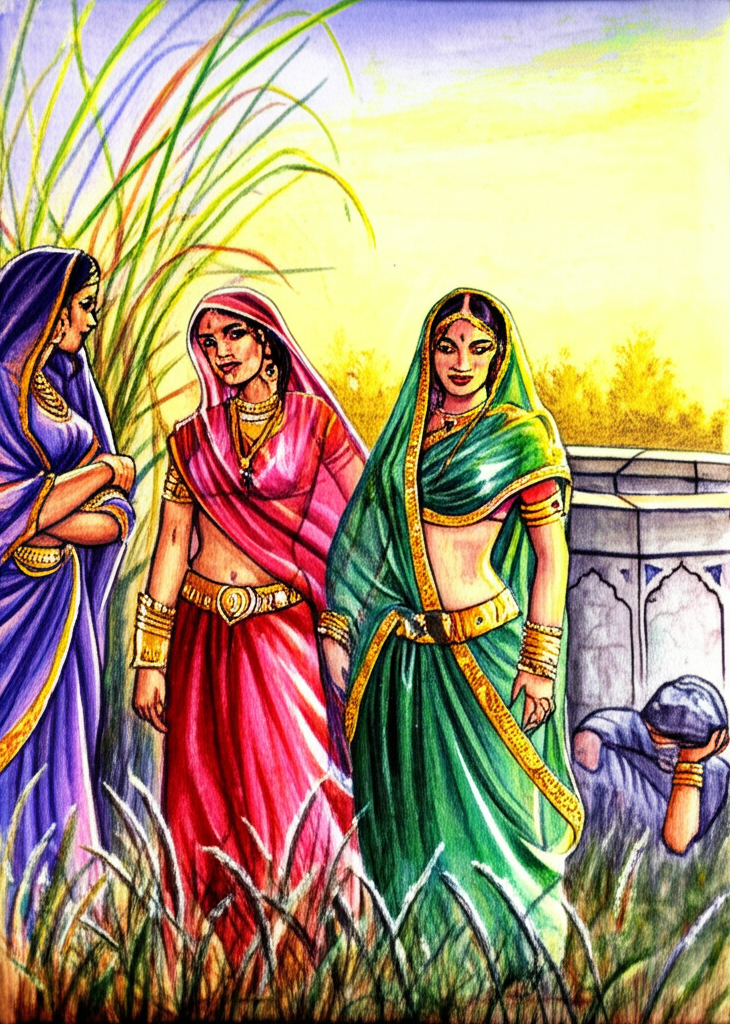
The first two women got their water and left, and Sachuli didn’t throw any rocks. But when the last woman, who was wearing lots of shiny jewelry, walked by, he threw a really big rock! She fell down and didn’t move. Her mouth looked a little like she was smiling. Sachuli thought, “Wow! She’s laughing so hard!” And he ran to get his mom. “Mom! Mom! Come see! I made her laugh!”
His mom came, and when she saw the woman wasn’t moving, she got scared. The woman was from a very important family, and her jewelry was worth a lot! Hungni quickly took off all the jewelry and threw the woman in the well.
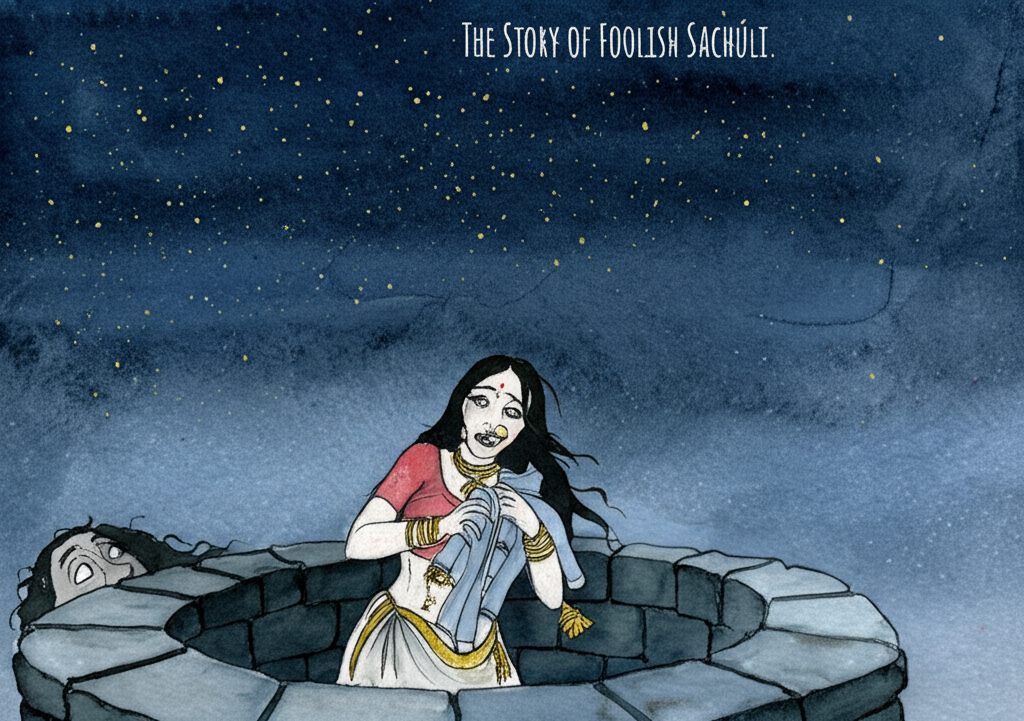
A few days later, the dead woman’s family sent someone around town with a drum. He shouted, “If you find a young woman with lots of gold necklaces, bracelets, and rings, you’ll get a big reward!” Sachuli heard him. He said, “I know where she is! My mom took all her jewelry and threw her in the well!”
The crier asked, “Can you go down in the well and get her?”
Sachuli said, “If you tie a rope around me and lower me down, I can get her!”
So they went to the well, which was close to Hungni’s house. When Hungni saw them coming, she knew what they wanted. She ran out, killed a sheep, and threw it in the well. Then she hid the dead woman.
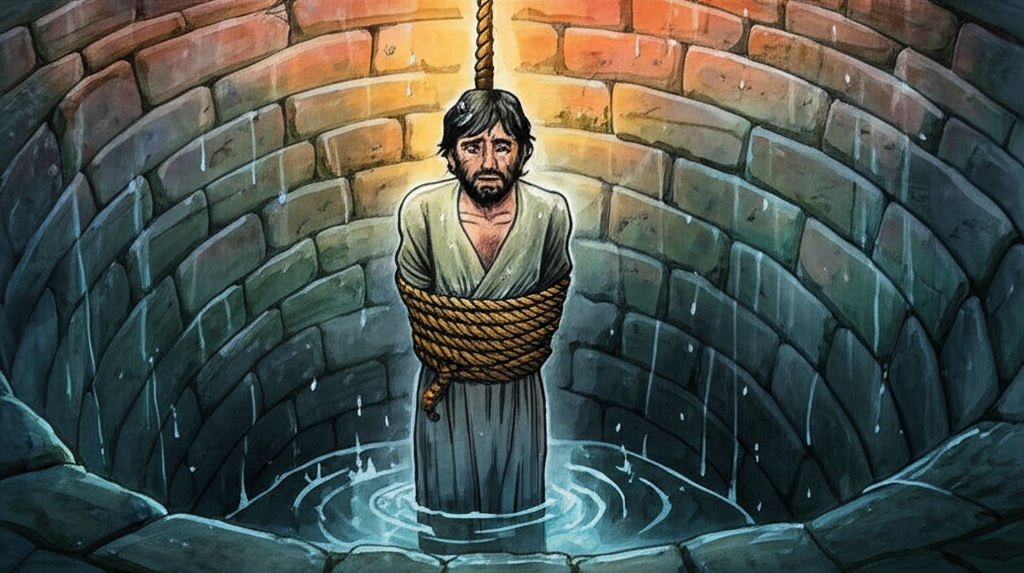
The crier got some helpers, and they lowered Sachuli into the well. “Does she have eyes?” Sachuli asked. “Of course! Everyone has eyes!” the men said. “Does she have a nose?” Sachuli asked. “Yes, she has a nose!” the men said. “Does she have a mouth?” Sachuli asked. “Yes!” the men said. “Does she have a long face?”
The men got annoyed. “What does he mean?” they said. “Nobody has a long face! Maybe she does, though. Yes, she has a long face!”
“Does she have a tail?”
“A tail? Nobody has a tail! Maybe he means long hair. Yes, she has a tail!”
“Does she have ears?”
“Of course! Everyone has ears!”
“Does she have four feet?”
“Four feet!” the men shouted. “Nobody has four feet! Maybe he means her hands are feet. Yes, she has four feet! Bring her up! Hurry!”
Then Sachuli brought up the sheep.
The men were super angry when they saw the sheep. They yelled at Sachuli, called him a silly liar, and stomped away.
Sachuli went home. As soon as his mom saw him, she ran and put the woman’s body back in the well. When he got inside, she hit him. “Mom,” he said, “give me some bread. I’m going to go away and disappear forever!” His mom made him some bread, and he left.
He walked and walked and walked for a long, long time.
Far away, a King’s ten camels were walking down the road. Each camel carried bags full of gold and silver coins. One of the camels broke free and wandered off. The camel drivers couldn’t find it. But Sachuli found it! He grabbed the camel and took it home.
“Mom! Mom! Look at all this money I found!” Sachuli shouted. Hungni was so excited to see the money! She quickly took off the bags and sent the camel away.
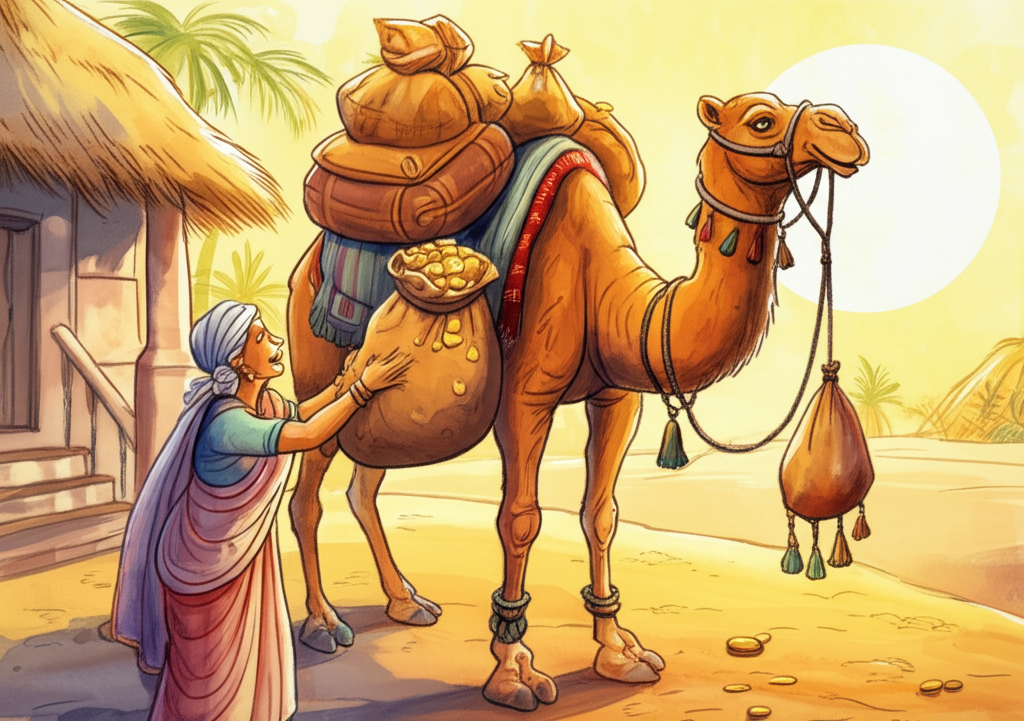
Then she hid the money and the jewelry she had taken from the woman. Because she was clever, she went and bought a bunch of candy and sprinkled it all over the house when Sachuli wasn’t looking. “Wow! Look at all this candy!” Sachuli said. “God made it rain down from the sky!” his mom said. Sachuli started eating the candy and told everyone in town that God had rained candy on his mom’s house.
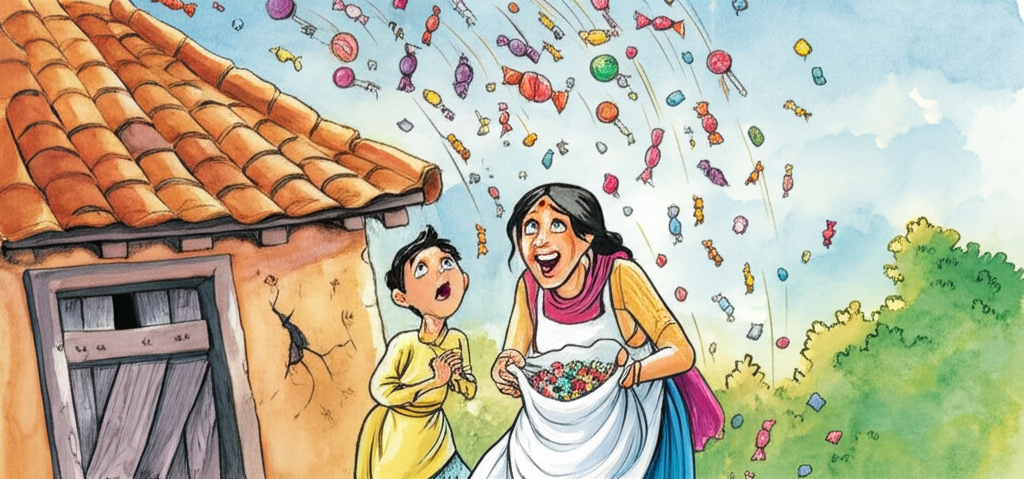
“That’s silly!” they said. “Yes, He did!” Sachuli said. “I ate some!” “No candy fell on our houses!” they said. “Yes, it did! The day my mom got all that money, God rained candy on our house!” “What a bunch of lies!” the people said. “Candy never falls from the sky! Why didn’t the candy fall on our houses? Why just yours? And what’s this about money?” Then they went to check Hungni’s house for money and candy, but they didn’t find anything because Hungni had hidden the money and thrown away the candy. “See?” they said to Sachuli. “Where’s your money? Where’s your candy? You’re a liar! Candy doesn’t fall from the sky! You tell such silly stories!” And they hit him. “But it did rain candy!” Sachuli said. “I ate it! It rained candy the day my mom got the money!”
Now, the King who lost his camel sent the crier around with his drum to find the camel and the money bags. “Whoever finds a camel carrying money bags and brings it back to the King will get a lot of money!” the crier shouted. “Oh!” Sachuli said. “I know where the money is! I found a camel with bags of money on its back, and I took it home to my mom! She took the bags off and sent the camel away!” So the crier went to find the money, and all the people in town went with him. But Hungni had hidden the money so well that they couldn’t find it, even though they looked everywhere. So they hit Sachuli and called him a liar. “I’m not lying!” Sachuli said. “My mom took the money the day it rained candy on our house!” So they hit him again and left. Then Hungni hit Sachuli and said, “You’re a terrible boy! You’re trying to get me beaten and thrown in jail by telling everyone about the money! Go away! I don’t want you anymore! Go away and disappear!” He said, “Okay, Mom. Give me some bread, and I’ll go.”
Sachuli left and took an axe with him. “How can I make myself disappear?” he wondered. So he climbed a tree and sat on a long branch. He started cutting the branch between himself and the tree.
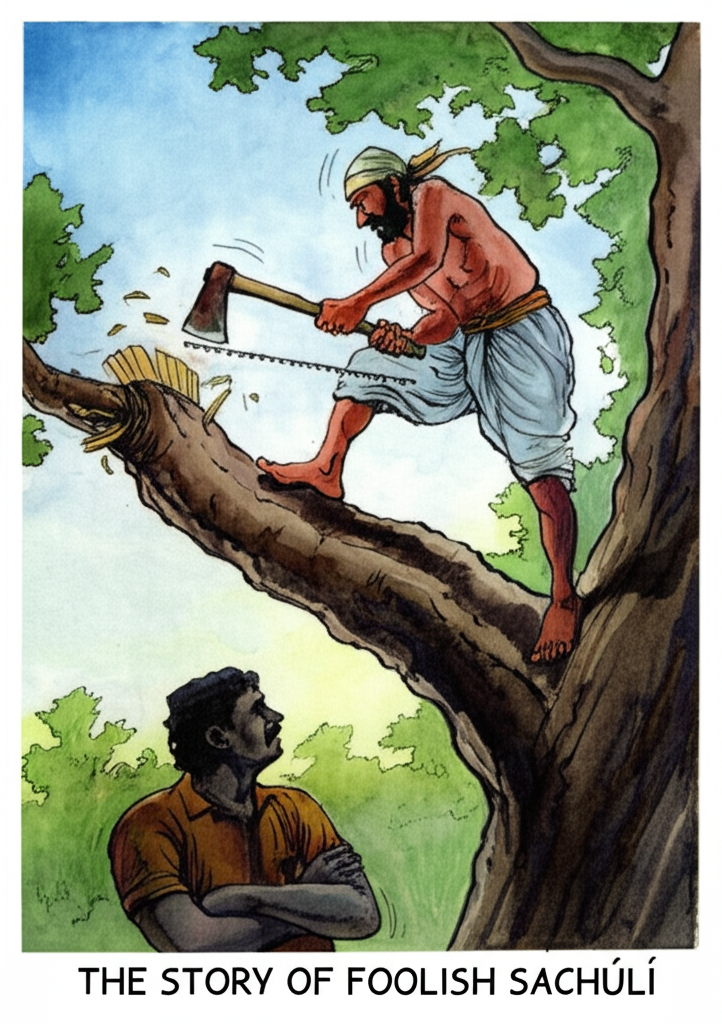
A man walked by and said, “What are you doing up there? You’ll fall if you cut that branch!” “What did you say?” Sachuli yelled, jumping down and grabbing the man’s hand. “When will I fall?” “How should I know? Let me go!” “I won’t let you go until you tell me when I will disappear forever!” Finally, the man said, “When you find a red string on your jacket, that’s when you will disappear forever.”
Sachuli went to the marketplace and sat near some tailors. One of the tailors threw some scraps of cloth away, and a red string landed on Sachuli’s coat. “Oh no!” Sachuli said when he saw the string. “Now I will disappear forever!” “How do you know that?” the tailors asked. “A man told me that when I found a red string on my jacket, I would disappear,” Sachuli said. The tailors laughed at him and made fun of him. But Sachuli went into the forest and dug a hole with his axe, then laid down in it. At night, a soldier walked by carrying a big jar of butter on his head. “This jar is so heavy!” the soldier said. “Is there anyone who will carry my butter home for me? I’ll give them a few coins!” Sachuli jumped out of the hole. “I’ll carry it for you!” he said. “Who are you?” the soldier asked, scared. “Oh, I’m someone who has disappeared,” Sachuli said. “I’m tired of laying here. I can’t lay here anymore.” “Well,” the soldier said, still scared, “you can carry my butter.”
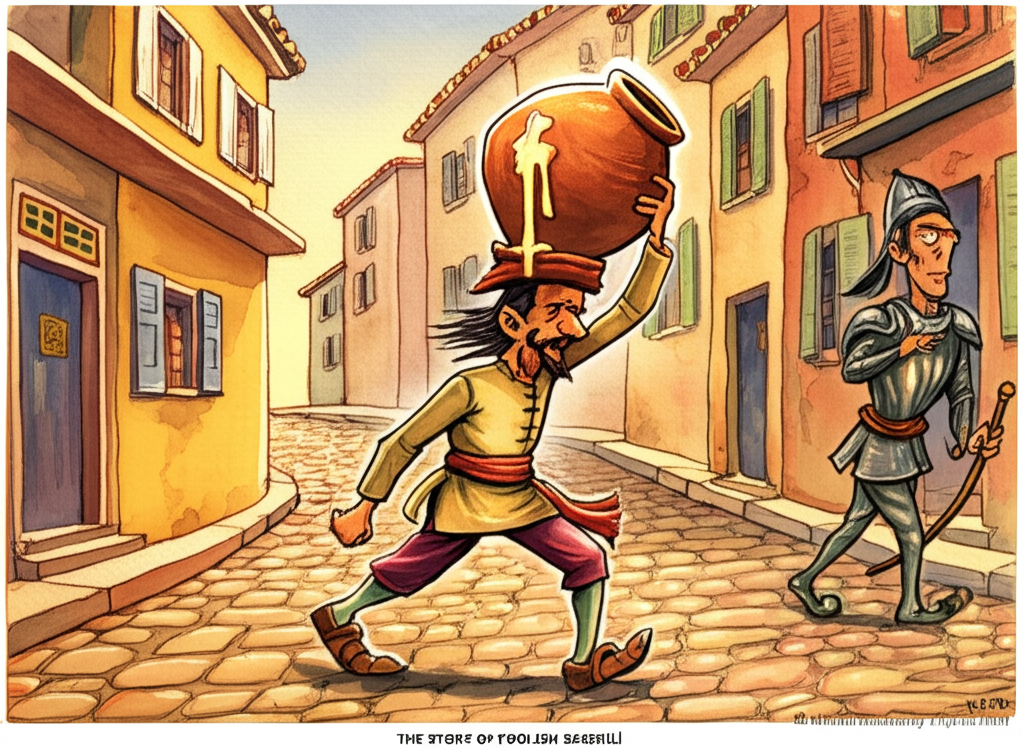
So Sachuli put the jar on his head, and the soldier followed him. “Now,” Sachuli said, “with these coins, I will buy a chicken. Then I will sell the chicken and her eggs. With that money, I’ll buy a goat. Then I’ll sell the goat and her milk and her skin, and I’ll buy a cow. Then I’ll sell her milk, and I’ll get married. Then I’ll have children, and they’ll say to me, ‘Daddy, do you want some rice?’ and I’ll say, ‘No, I don’t want any rice!’” As he said, “No, I don’t want any rice!” he shook his head. The jar of butter fell off his head and broke! The butter spilled everywhere. “Oh no! What have you done?” the soldier shouted. “Why did you shake your head?” “Because my children asked me to have some rice, and I didn’t want any, so I shook my head!” Sachuli said. “Oh,” the soldier said, “he’s completely silly!” The soldier went home, and Sachuli went back to his mom. “Why have you come back?” she asked. “I’ve been gone for twelve years!” Sachuli said. “What lies!” she said. “You’ve only been gone a few days! Get out! I don’t want any liars here!”
Sachuli asked her to give him two flatbreads, which she did. Then he went to the forest, and it got dark. Five fairies lived in this forest. As Sachuli walked, he broke his flatbreads into five pieces and said, “Now I’ll eat one, then the second, then the third, then the fourth, and then the fifth!” The fairies heard him and got scared. They said to each other, “What should we do? This man is going to eat us all up! We have to save ourselves! We’ll give him something!” So they all went to Sachuli and said, “If you promise not to eat us, we’ll give you a present!” Sachuli didn’t even know there were fairies in the forest. “What will you give me?” Sachuli asked. “We’ll give you a magic cooking pot! When you want something to eat, just ask the pot for it, and you’ll get it!”
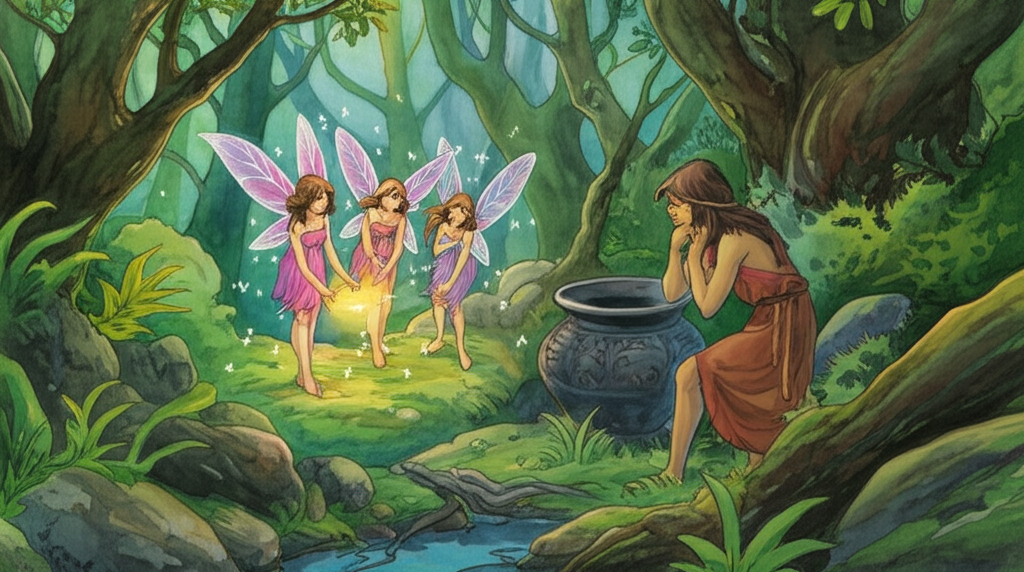
Sachuli took the pot and went to the marketplace. He stopped at a food shop and asked for some rice with meat. “Rice with meat? We don’t have any here!” the shop owner said. “Well,” Sachuli said, “I have a cooking pot here. I just have to ask it for any dish I want, and I get it right away!” “That’s silly!” the man said. “Just watch!” Sachuli said to the cooking pot, “I want some rice with meat!” Right away, the pot was full of rice with meat! Everyone in the shop helped him eat it because it was so yummy. The cook thought, “I have to get that pot!” So he gave Sachuli a drink that made him sleepy. While Sachuli slept, the cook stole the magic cooking pot and put a regular pot in its place. Sachuli went home with the regular pot and said, “Mom, I brought home a cooking pot! If you ask it for any food, you’ll get it!” “Nonsense!” Hungni said. “You’re telling lies!” “It’s true, Mom! Just watch!” And he asked the pot for different dishes, but nothing happened. Hungni got really mad. “Go away!” she said. “Why do you keep coming back? I don’t want any liars here!” “Give me five flatbreads, and I’ll go,” her son said. So she made him the bread, and he left for the forest where he met the five fairies. As he walked, he said, “I’ll eat one, and I’ll eat two, and I’ll eat three, and I’ll eat four, and I’ll eat five!” The five fairies heard him and were terrified. “This bad man is back!” they said. “He’s going to eat all five of us! What should we do? Let’s give him a present!” So they went to Sachuli and said, “Here’s a box for you. Whenever you want some clothes, just tell this box, and it will give them to you! Take it, and don’t eat us!”
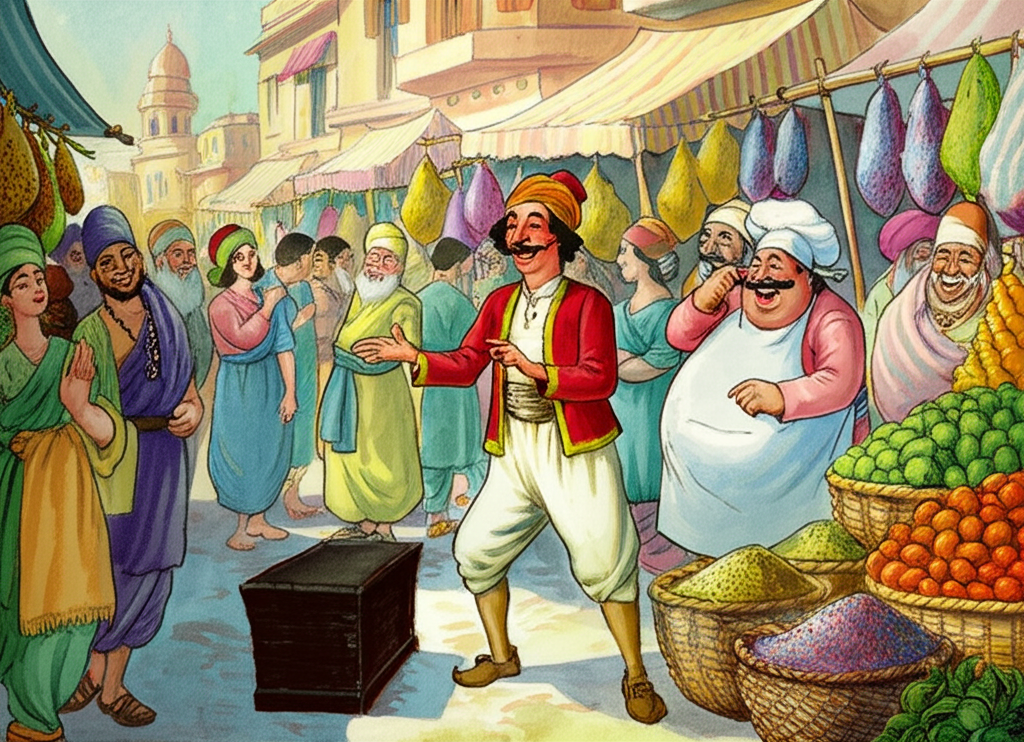
So he took the box and went to the marketplace. He stopped at the food shop again and asked the cook for a red silk outfit, a pair of long black pants, a blue hat, and red shoes. The cook laughed and asked how he could have such beautiful things. “Well,” Sachuli said, “I have a box! When I ask it for the outfit, pants, hat, and shoes, I’ll get them!” So the cook laughed at him. “Just watch!” Sachuli said. “Box, give me a red silk outfit, a pair of long black pants, a blue hat, and red shoes!” And there they were right away! The cook was so happy! He said to himself, “I have to have that box!” He gave Sachuli a good dinner and a sleepy drink, and Sachuli fell asleep. While he slept, the cook came and stole the magic box and put a regular box in its place. In the morning, Sachuli went home to his mom and said, “Mom, I brought you a box! You just have to ask it for any clothes, and you’ll get them!” “Nonsense!” his mom said. “Don’t tell me those lies!” “Just watch, Mom! I’m telling the truth!” he said. He asked the box for coats and all sorts of things, but nothing happened. His mom got angry and said, “You liar! You naughty boy! Go away, and don’t come back anymore!” She broke the box into pieces and threw them away. “Well, Mom, make me some flatbreads.” So she baked him the bread, gave them to him, and sent him away. He went to the fairies’ forest. As he walked, he said, “Now I’ll eat one, then two, then three, then four, then five!” The five fairies were very scared. “This man is back to eat all five of us! Let’s give him a present!” So they went to him and gave him a rope and a stick. They said, “Just say to this rope, ‘Tie that man up!’ and he’ll be tied up right away! And to this stick, ‘Hit that man!’ and the stick will hit him!” Sachuli was happy to get these things because he knew what had happened to his cooking pot and box. So he went to the marketplace. At the food shop, he said, “Rope, tie up all the men that are here!” The cook and everyone in the shop were tied up instantly. Then Sachuli said, “Stick, hit these men!” And the stick began to hit them! “Oh, stop! Stop hitting us! Untie us, and I’ll give you your pot and your box!” the cook shouted. “No, I won’t stop hitting you, and I won’t untie you until I have my pot and my box!” The cook gave them both to him, and he untied the rope. Then Sachuli went home. When his mom saw him, she was very angry, but he showed her the box and the cooking pot. She saw that he had told her the truth. So she called the doctor, who said that Sachuli was smart and not silly. Then he and Hungni found a wife for Sachuli and had a big wedding for him, and they all lived happily ever after!